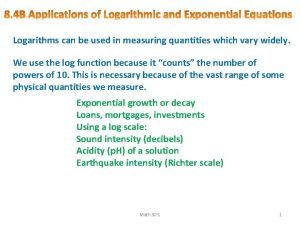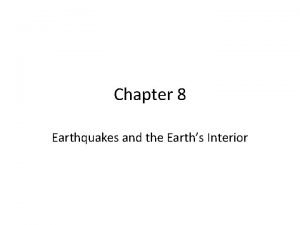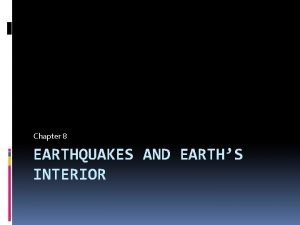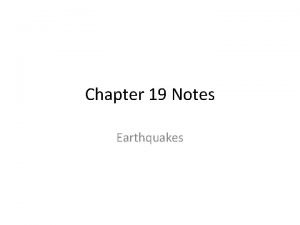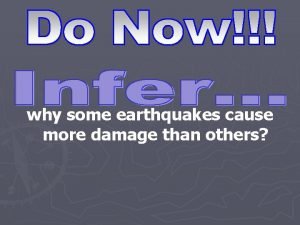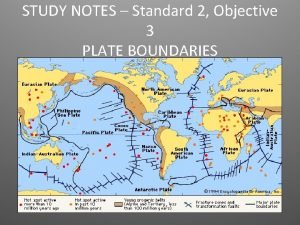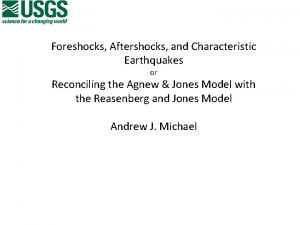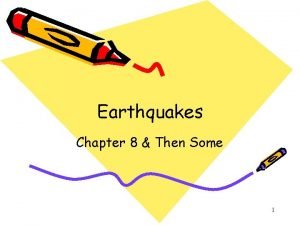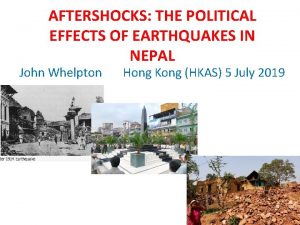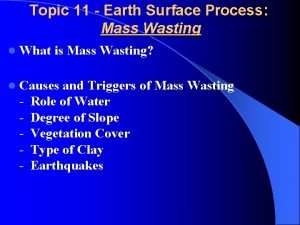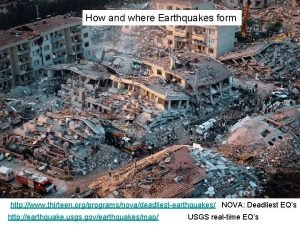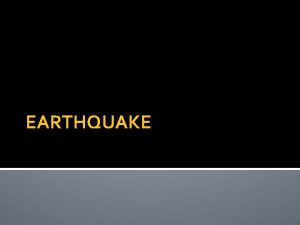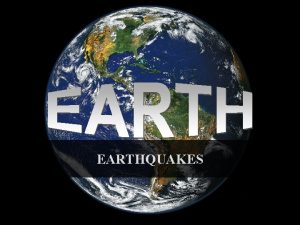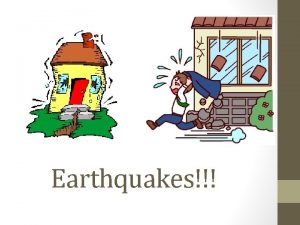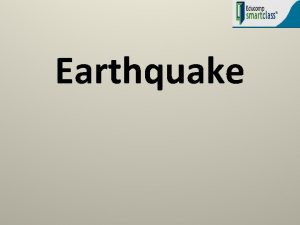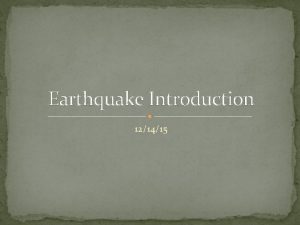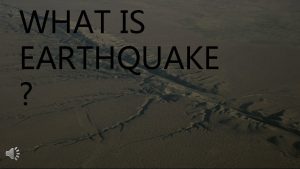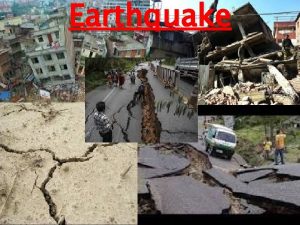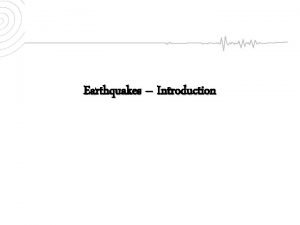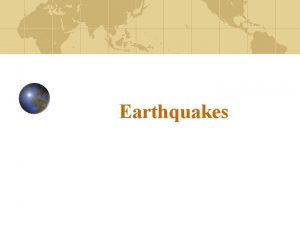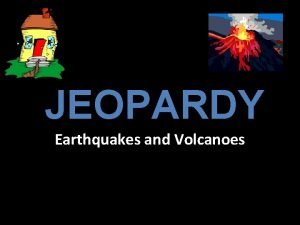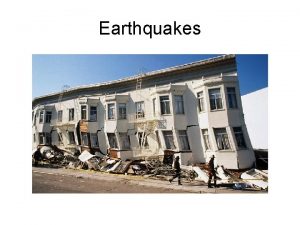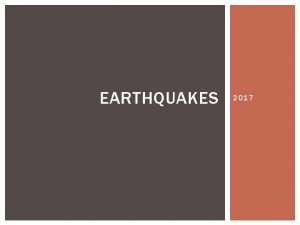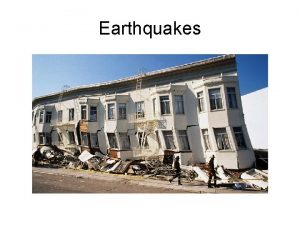Earthquakes Chapter 8 Earthquakes What is an earthquake



















- Slides: 19

Earthquakes Chapter 8

Earthquakes ► What is an earthquake? § (def. ) Vibration of Earth produced by a rapid release of energy ►Usually along cracks in the earth called faults ► Earthquakes usually do not “occur” on the surface ► The point where an earthquake occurs is called the focus ► The epicenter is the location DIRECTLY above the focus

Earthquakes ► What causes earthquakes? § Rocks in Earth’s crust is stressed and pulled § This action stores elastic energy ► Once the build up of energy exceeds the strength of the rock the energy is released ► The energy is released as seismic waves

Earthquakes ► Types of seismic waves ► Surface Waves § Travel along the surface of the earth § Move side-to-side AND up and down ► Body Waves § Travel through Earth’s interior

Earthquakes ► Two types of Body Waves: P and S ► P Waves (Primary waves) § Compression waves since they push and pull rocks § Fastest moving seismic wave § Able to move through solid rock and fluids ►S Waves (Secondary waves) § Slower than a P wave § Can ONLY move through solid rock ►A seismograph is used to detect seismic waves

Earthquakes

Earthquakes

Earthquakes ►A typical seismogram of an earthquake:

Richter Scale ► The Richter scale measures the magnitude of an earthquake § Magnitude refers to the size of seismic waves ►A tenfold increase in wave amplitude (height) is equal to an increase of 1 on the scale ► Draw back: only useful for shallow earthquakes

Continental Drift ► German meteorologist, Alfred Wegener, proposed a radical idea: continental drift ► Wegener noticed the continents seemed to fit together like pieces of a puzzle ► He proposed the continents are “floating” on the molten mantle and were once joined together ► This Supercontinent was known as Pangaea

Continental Drift ► Scientists dismissed his theory ► Wegener argued that the same fossils are found on different landmasses ► Ex. – Mesosaurus on Africa and S. America

Continental Drift ► More supporting evidence: ► Similar rock types and structures § Appalachian Mountains were once a large mountain chain like the Rockies § The same types of rocks that are found in North Carolina to NY are found in northern Britain and Scandinavia

Continental Drift ► The continents of North America, Europe, and Asia were known as Laurasia ► South America, Africa, India, Antarctica, and Australia were known as Gondwanaland ► The ocean south of Asia was called the Tethys Sea ► The rest of the water on Earth was called Panthalassa § The remnants of this ocean is the Pacific

► Panthalassa Gondwanaland Laurasia

Seafloor Spreading

Seafloor Spreading ► Seafloor spreading refers to the process by which plate tectonics produce new oceanic crust ► Where is this taking place? § Atlantic Ocean § Eastern Africa?


Seafloor Spreading ► Rift valleys are found along the center of the mid-ocean ridges. § Place where magma is forced upwards ► Oceanic ridges areas where the seafloor is elevated due to seafloor spreading ► The seafloors are spreading at a rate of 5 cm/year ► This means the ocean basins are no older than 200 million years old

 Http://earthquake.usgs.gov/earthquakes/map/
Http://earthquake.usgs.gov/earthquakes/map/ Chapter 8 section 3 earthquakes and society answer key
Chapter 8 section 3 earthquakes and society answer key Chapter 8 earthquakes and volcanoes
Chapter 8 earthquakes and volcanoes Chapter 8 earthquakes and earth's interior
Chapter 8 earthquakes and earth's interior Chapter 19 earthquakes
Chapter 19 earthquakes Chapter 8 earthquakes and earth's interior
Chapter 8 earthquakes and earth's interior Chapter 19 earthquakes
Chapter 19 earthquakes In what section of earth do earthquakes happen?
In what section of earth do earthquakes happen? Btn earthquakes
Btn earthquakes Explanation of natural disaster
Explanation of natural disaster A large crack in the earth formed by a river or earthquakes
A large crack in the earth formed by a river or earthquakes Why some earthquakes cause more damage than others
Why some earthquakes cause more damage than others Frequent earthquakes in an area may indicate
Frequent earthquakes in an area may indicate Earthquakes
Earthquakes Quiz 1 earthquakes
Quiz 1 earthquakes Earthquakes
Earthquakes Mass wasting
Mass wasting Plastic deformation earthquakes
Plastic deformation earthquakes Why do earthquakes occur
Why do earthquakes occur What are the factors of earthquake
What are the factors of earthquake
